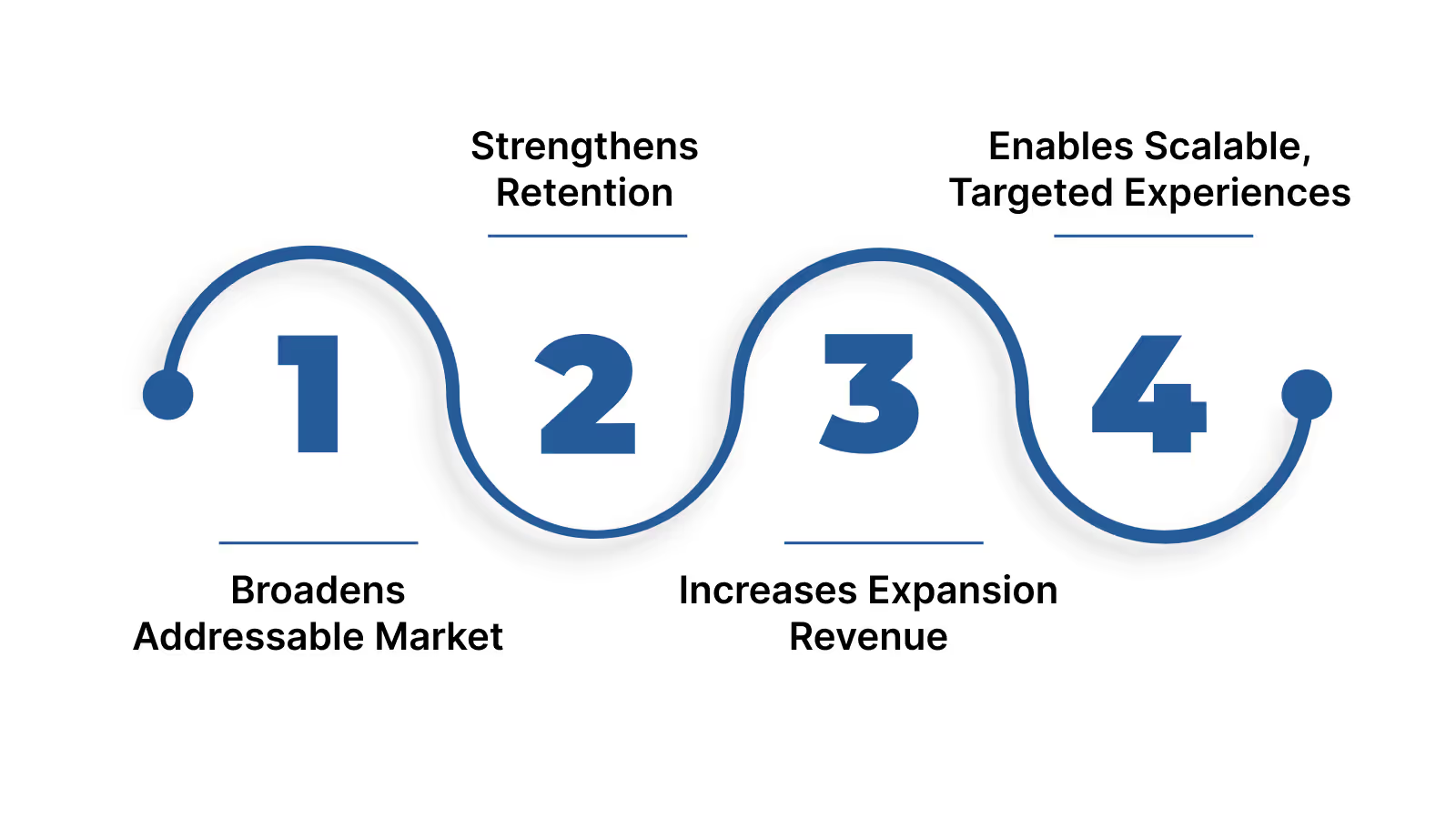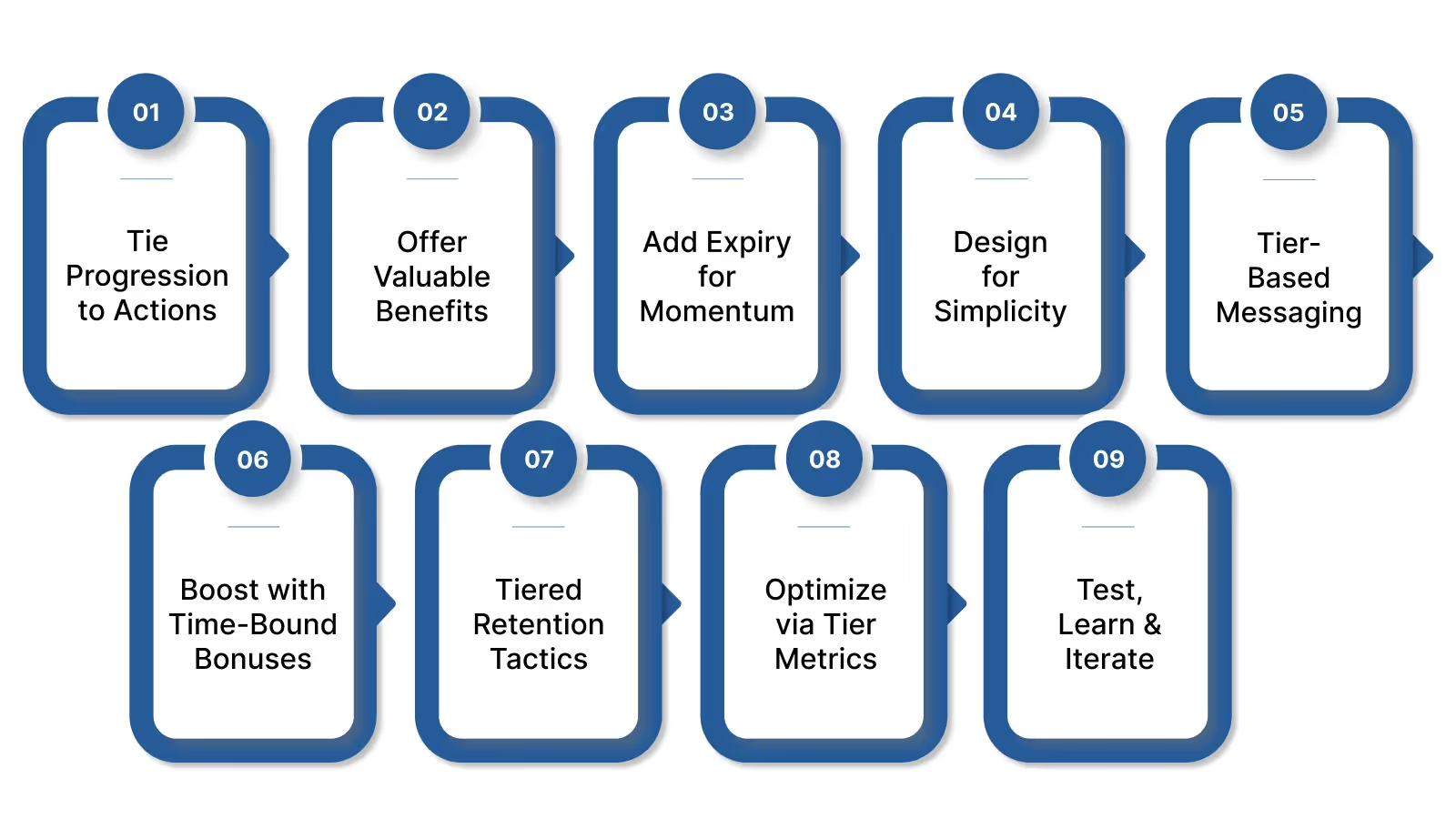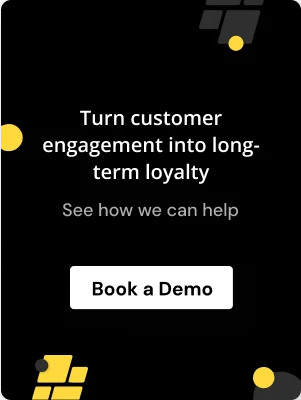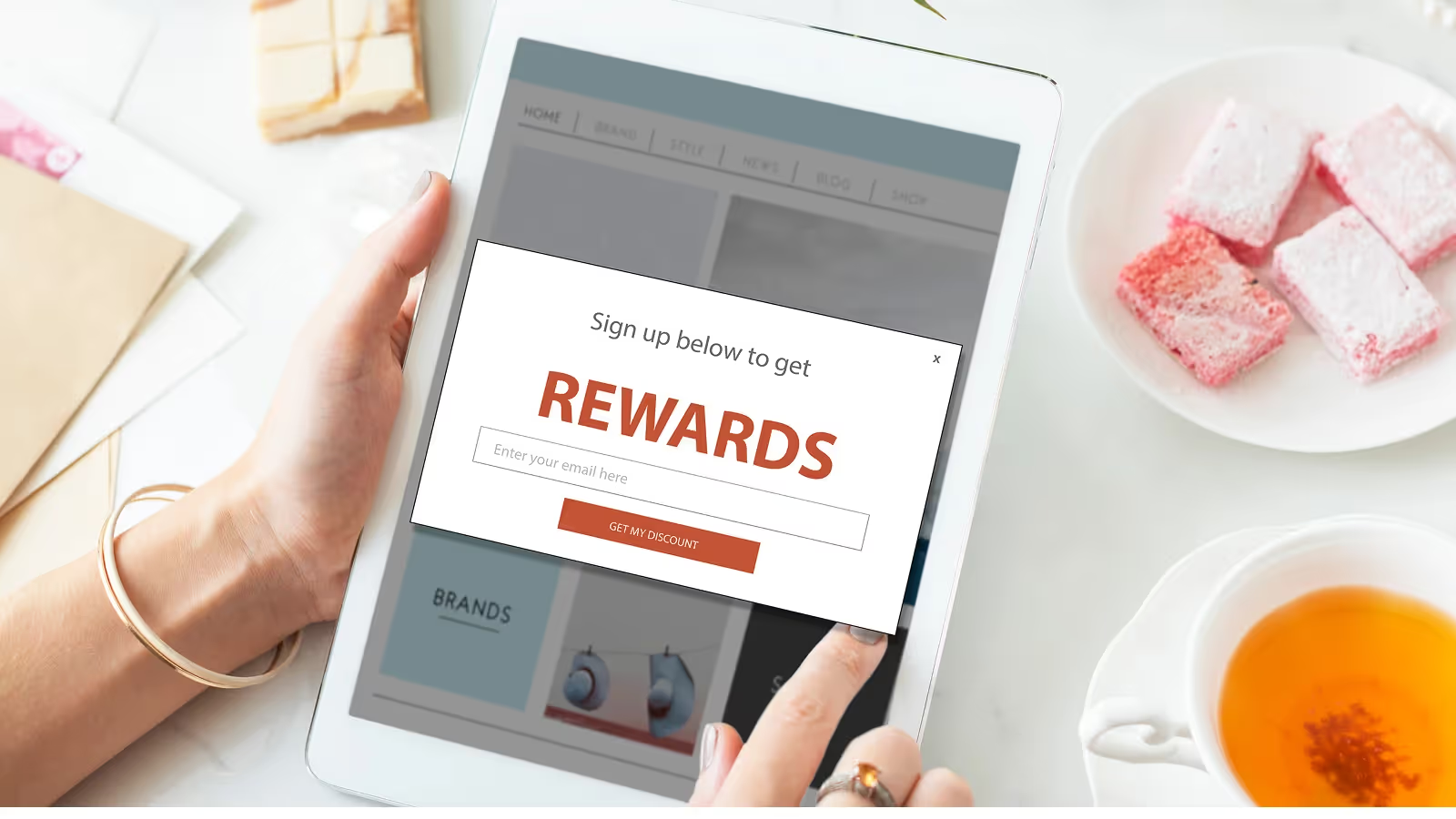.avif)
.avif)
For growth-focused businesses, one of the most overlooked yet powerful levers is pricing, especially tiered loyalty programs. Whether you're in SaaS, fintech, eCommerce, or DTC, tiered models consistently drive deeper customer engagement and stronger returns.
In fact, businesses with tiered loyalty programs report 1.8x higher ROI compared to those without tiers. And 37% of customers say they’re willing to pay for access to an enhanced membership tier, signaling a clear opportunity to monetize loyalty.
Yet, many teams struggle with execution. Poorly designed tiers can lead to churn, low upgrade rates, and operational complexity. This guide breaks down how to structure and scale a tiered program that works, from real-world examples to actionable frameworks you can apply right away.
TL;DR
- Tiered pricing helps businesses match value to customer segments.
- There are three core types: feature-based, usage-based, and user-based.
- Done right, tiers improve LTV, reduce churn, and increase upsell velocity.
- Common pitfalls include overcomplication, poor upgrade triggers, and unclear tier value.
- Platforms like Nector help automate, personalize, and analyze tier logic without heavy lifting.
What Is a Tiered Business Model?
A tiered business model gives customers multiple pricing levels, each designed to match how much value they need or how much they’re ready to pay. As users move up through the tiers, they unlock added features, usage limits, support levels, or even exclusive perks.
You’ve likely seen this in action with SaaS products, loyalty programs, or eCommerce memberships. What makes it so effective is the built-in flexibility; it lets users start with the basics and scale gradually, without overwhelming them at the start.
For brands, the value goes even deeper. Tiered models create space to segment your audience, personalize offers, and grow customer lifetime value without pushing away budget-conscious users. It becomes a structure that supports long-term engagement instead of just upfront conversion.
The key, however, lies not just in the structure but in the pricing logic behind each tier. That’s where the mechanics of tiered pricing take center stage.
How Tiered Pricing Works
Tiered pricing operates on a simple but powerful logic: customers start at a foundational level and graduate to higher tiers as their engagement, usage, or spending increases. But the execution isn't as straightforward as it sounds.
Each tier is usually defined by a set of progression triggers and milestones that indicate a user is ready for more value or willing to pay more. These triggers can vary based on your business model:
- Spend-based thresholds: For example, a customer who crosses $500 in annual spend might unlock priority support or exclusive discounts.
- Feature-based needs: A user exploring API access, multi-user logins, or advanced reporting may be ready for a higher plan.
- Usage frequency: More logins, transactions, or interactions can signal that a user sees recurring value and is ripe for an upgrade.
- Loyalty behaviors: Users who refer others, leave reviews, or participate in your programs often signal strong brand affinity and potential for upsell.
The real challenge comes in tracking and acting on these triggers. Many teams try to hardcode them directly into their platforms or run one-off scripts, but this leads to brittle systems and data blind spots. Without automation and centralized logic, opportunities are missed, tier assignments become inconsistent, and teams are stuck firefighting exceptions.
But before diving into tooling and automation, it’s important to understand the foundations. The type of tiered model you choose will directly shape how users interact with your product, how value is perceived, and how revenue scales over time.
Key Types of Tiered Business Models

Choosing the right tier structure isn’t just about pricing; it’s about how your business delivers and communicates value. The structure you adopt influences customer onboarding, retention, and how easily users move up the value chain. Below are the most common tiering approaches used across growth-stage companies.
1. Feature-Based Tiers: This model unlocks progressively advanced product capabilities at each tier. It’s most effective when your product delivers distinct value at different levels of complexity. Common in SaaS, fintech, and creator platforms, it allows teams to balance accessibility with premium utility.
Example: Slack’s pricing tiers reflect clear feature progression. The free plan offers basic chat and limited message history, while paid plans introduce admin oversight, SSO, analytics, and extended integration features essential for larger or regulated teams.
2. Usage-Based Tiers: Here, pricing is directly linked to how much of a product or service the customer consumes. This works well when customer needs vary significantly in scale, such as infrastructure, storage, or messaging volume.
Example: AWS scales pricing based on compute hours, API calls, or storage used. This ensures smaller teams aren’t overpaying, while high-usage customers contribute proportionally to the value they extract.
3. User-Based Tiers: In this model, pricing increases with the number of seats or users accessing the product. It’s often seen in collaborative or B2B tools where each user drives incremental operational complexity and value.
Example: Figma and Notion charge per editor or team member. Higher tiers add role-based access, advanced permissions, or workspace-level controls catering to growing teams without confusing smaller ones.
Some businesses blend two or more structures, for example, combining feature gating with usage thresholds. That said, clarity should always take priority over cleverness. If customers can’t quickly understand what they’re paying for and why it matters, even the best-designed tiers can underperform.
4. Loyalty Programs and VIP Tiers: Loyalty programs incentivize sustained engagement and make higher tiers aspirational. Tiered structures often align with pricing models, rewarding customers for their commitment and encouraging progression to higher-value plans.
But making this work at scale requires more than a good reward system; it needs built-in logic that responds to user behavior without manual input. With tools like Nector, brands can automate VIP tier upgrades and configure smart coin expiry systems, ensuring perks feel timely and relevant while maintaining backend simplicity.
These features help brands reduce friction, drive urgency, and keep customers moving upward, turning tiered loyalty into a practical lever for long-term growth.
Read: Effective Tiered Reward Levels and Benefits Guide
Benefits of a Tiered Business Model

When designed with precision, a tiered pricing model becomes more than a revenue strategy; it acts as an operational blueprint for how value is created, delivered, and expanded over time. For growing businesses, the right structure doesn’t just optimize pricing. It aligns product, sales, and customer success teams around a shared understanding of customer segments and their evolving needs.
1. Broadens Your Addressable Market (TAM)
Tiered models allow companies to serve a diverse set of customers without diluting value. Entry-level or freemium tiers help attract price-sensitive or early-stage users, lowering the barrier to adoption. At the same time, higher-tier offerings provide enterprise-ready capabilities with the margins and features that justify premium pricing. This layered approach allows companies to grow revenue across a spectrum of customer types without building entirely separate products.
2. Strengthens Retention Through Value Progression
Customers are more likely to stay engaged when they feel there’s a clear path forward. Tiered models create built-in milestones, whether it's accessing new features, support levels, or usage capacity, which give users a reason to grow with the product. Rather than pushing for upgrades, teams can focus on helping customers reach natural inflection points where moving to a higher tier makes business sense.
3. Increases Expansion Revenue Without Friction
By clearly differentiating what’s included at each tier, businesses create logical upsell triggers. These aren’t forced conversations; they’re the result of users outgrowing their current tier and seeing visible benefits from upgrading. Done right, this encourages self-serve expansion, reducing dependency on sales-heavy motions and improving unit economics.
4. Enables Targeted Customer Experiences at Scale
Not every customer requires the same support or onboarding. Tiered models allow teams to deliver differentiated experiences aligned with customer maturity. For instance, higher tiers might include access to dedicated CSMs, advanced analytics, or priority SLAs, while lighter tiers focus on product-led onboarding. This ensures resources are invested where they have the most impact.
For businesses, tiered models offer an opportunity to turn pricing into a strategic lever for growth, not just a billing mechanism. When tiers are backed by strong data, cross-functional alignment, and thoughtful execution, they drive retention, unlock expansion, and support long-term scalability.
Tiered Business Model Examples
Real-world applications of tiered models reveal how clarity in progression drives both user satisfaction and business growth. Below are two examples where thoughtful alignment between customer behavior and tier design makes the loyalty experience feel both aspirational and attainable.
Starbucks Rewards (Food & Beverage, Frequency-Based Loyalty)
Starbucks’ loyalty program uses a simple but powerful principle: frequent engagement matters more than high-value one-time purchases. Members earn 1 Star per $1 spent and can start redeeming rewards like free add-ons or bakery items with as few as 25 Stars. The program introduces tiered recognition early. On collecting your 5th Star, you're promoted to the Green tier, which unlocks benefits like free in-store refills and personalized offers. Upon reaching your 25th Star, you advance to the Gold tier, where perks expand to include birthday rewards, priority access to offers, and more frequent Double Star Days. Once you become a Gold member, your Stars reset to zero, and you begin accumulating again to maintain your tier status and continue unlocking rewards.
This milestone-based model encourages steady, repeat visits. By tying rewards to frequency rather than spend alone, Starbucks ensures the program feels accessible while still motivating higher engagement over time.
Target Circle (Retail, Spend-Based Tiering)
Target Circle’s tiered program takes a spend-driven approach to engagement. Members earn 1% back on every eligible purchase and receive access to exclusive deals, birthday gifts, and personalized recommendations. But the real distinction emerges at the Circle 360 level, a premium paid tier offering unlimited same-day delivery and free shipping, designed for high-frequency shoppers and online-first buyers.
This dual-tiered model, with a free baseline and a premium opt-in, enables Target to serve casual customers while offering clear, added convenience and value for those willing to invest more. It’s a structure that doesn’t alienate the masses, yet rewards deeper brand involvement with time-saving and service-oriented benefits.
Read: What Is Loyalty Management? Benefits & Tips for D2C Brands in 2025
Best Practices for Tiered Business Model Implementation

A tiered business model can significantly boost customer retention and lifetime value if it’s executed with precision. For businesses built around loyalty, referrals, and rewards (rather than SaaS features), the goal isn’t to lock value behind paywalls; it’s to encourage progressive engagement and reward sustained behavior.
Done right, tiered models deliver a better customer experience, lower churn, and create clear economic incentives for repeat engagement. But most programs fail when tiers are arbitrary, rewards are disconnected from effort, or progression lacks transparency.
Here’s how to get it right:
1. Tie Tier Progression to High-Value Customer Actions
Tiers shouldn’t be based on vanity metrics, they should reward repeat behaviors that drive revenue. This includes:
- Total spend (e.g., $300+ in 6 months)
- Purchase frequency (e.g., 5 orders in 90 days)
- Referrals (e.g., refer 3 new customers to move up)
- Engagement (e.g., completing reviews, using coupons, participating in events)
Make the rules visible and achievable. Customers are far more likely to stay engaged if they know exactly how to progress and why it matters.
2. Offer Tiered Benefits That Grow in Meaningful Value
Avoid the mistake of stacking superficial perks just to fill each level. Each tier should meaningfully increase in both monetary value and emotional relevance.
Instead of just offering a bigger discount each time, think about:
- Tier 1: Welcome offer, basic cashback or points
- Tier 2: Free shipping, early access, birthday gifts
- Tier 3: VIP-only products, concierge support, double point days, exclusive invites
Your top-tier customers are your most profitable; they deserve thoughtful, differentiated treatment that goes beyond discounts.
3. Incorporate Expiry & Requalification to Sustain Momentum
Tiers shouldn’t be permanent. If customers slip in their activity, they should move down the ladder gently.
Introduce:
- Rolling qualification windows (e.g., "spend $300 in 6 months to retain Gold")
- Point expiry mechanisms to prevent stockpiling
- Re-engagement campaigns are triggered when activity drops
Platforms like Nector support Smart Coin Expiry Systems and automated tier downgrades, reducing manual admin while driving urgency. When customers know that benefits can be lost, they’re more likely to stay active.
4. Design for Simplicity — Internally and Externally
Confusion kills participation. Keep your tier structure easy to understand and frictionless to use:
- Limit to 3 or 4 tiers max
- Use side-by-side visual comparisons of benefits
- Display tier progress prominently on customer dashboards
- Avoid vague language like "exclusive" or "premium" without a clear explanation
For your internal teams, make sure reporting, automation, and customer support workflows are not manually managed.
5. Personalize Communication by Tier
Generic emails don’t resonate with top-tier members. Your communication should reflect a customer’s current tier and guide them toward the next one.
Use:
- Tier-based subject lines (“Gold Status Unlocked: Here’s What’s Next”)
- Progress nudges (“You’re just $42 away from unlocking VIP access”)
- Milestone celebrations (“3 referrals complete – you’re 1 step away from an upgrade”)
Every message should reinforce value while driving the next behavior.
6. Incentivize Upward Movement Through Time-Limited Bonuses
If tier progression feels too slow, interest fades. Add short-term incentives that give customers a push:
- “Earn double points this weekend and fast-track to Silver.”
- “Refer one friend by Friday and unlock Gold early”
- “Spend $50 more this month to keep your Platinum tier.”
These timely rewards turn long-term programs into immediate action.
7. Segment Retention Tactics by Tier
Not all churn risks are equal. A Tier 3 customer slipping into inactivity is more urgent than a Tier 1 user going dormant after one small order.
Use tier segmentation to:
- Trigger winback offers for high-tier drop-offs
- Prioritize CSM or support outreach for top tiers
- Send reactivation reminders tailored to tier loss
Each level of engagement requires its own retention logic.
8. Benchmark and Adjust Based on Tier-Level Metrics
Don’t measure performance solely in terms of total program participation. Instead, track by tier:
- Upgrade rate: % of users progressing each quarter
- Redemption behavior: Which tiers redeem points or rewards most?
- Revenue per tier: CLV differences between Silver, Gold, and Platinum
- Churn within tier: Are top-tier users lapsing? Why?
These insights guide refinement, whether it's updating thresholds, rebalancing perks, or simplifying the path to upgrade.
9. Test, Learn, and Iterate
Your first draft won’t be perfect—and that’s okay. Set up A/B tests on:
- Tier thresholds (e.g., $200 vs $250 to reach Gold)
- Perks offered (free shipping vs bonus coins)
- Progress triggers (number of purchases vs spend volume)
Use real behavioral data to fine-tune your model, instead of assumptions.
Tiered loyalty models aren’t just a branding layer—they’re a system for turning engagement into revenue. When designed with purpose, tiers give customers a reason to stay longer, spend more, and refer often.
The most effective programs are:
- Behavior-driven
- Transparent
- Rewarding in proportion to the value delivered
- Automated and integrated at scale
Whether you’re launching a new loyalty program or refining an existing one, aligning your tiers with customer behaviors and business outcomes is key. And with platforms like Nector, much of the heavy lifting, automation, and segmentation can be done without relying on manual operations.
Common Pitfalls to Avoid in Tiered Business Models
- Assuming high usage equals upgrade intent – Frequent use doesn’t mean customers see value in paying more without contextual nudges.
- Managing tier transitions manually – Spreadsheets and tags don’t scale; automation is essential for accuracy and efficiency.
- Forcing abrupt tier upgrades – Sudden switches without grace periods or value previews can erode trust and increase churn.
- Designing tiers around internal goals, not customer behavior – Misaligned thresholds confuse users and reduce upgrade motivation.
- Sending generic messages across tiers – One-size-fits-all communication flattens the experience and undercuts perceived value.
- Keeping tier structures static – Without regular updates based on user data, tiers lose relevance and impact over time.
- Hiding progress indicators – If users can’t track how close they are to the next tier, they won’t engage or aspire to level up.
Together, avoiding these pitfalls and designing with real customer behavior in mind makes your tiered model more than a pricing tactic; it becomes a growth engine. The goal isn’t just movement between tiers, but meaningful, long-term engagement at every level.

Wrapping up
Managing tier eligibility, triggers, and rewards manually is not only tedious, it’s error-prone. Nector removes this complexity.
With a unified dashboard, automated behavioral triggers, and plug-and-play integration with your loyalty stack, Nector helps you:
- Define and update tiers with custom rules
- Track user movement in real time
- Personalize rewards per tier without hardcoding logic
So you spend less time managing tiers and more time building meaningful customer relationships. Click here for a free demo.
FAQs
What industries are best suited for tiered models?
Tiered models are particularly effective in SaaS, fintech, online education, eCommerce, and F&B, anywhere customer engagement and retention play a central role.
How many tiers should I create?
Most businesses find success with three to five tiers. This range offers enough differentiation to reward progress without overwhelming users. More than five tiers can lead to decision fatigue and confusion, especially if the value differences aren’t clearly communicated.
What’s the difference between tiered pricing and volume pricing?
Tiered pricing offers multiple plans. Volume pricing gives discounts as usage goes up, often within a single plan.
Can I change my tier structure later?
Yes, but do it thoughtfully. Announce changes early, explain the reason clearly, and offer grace periods or legacy pricing to ease the transition and reduce churn.
Start Building Customer Retention That Lasts









